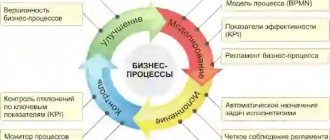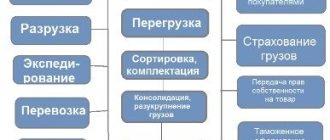Complete overview of concepts
B2b, b2c, b2g, c2c - what is it? The names of the business areas described in our article come from English-language business usage. These are sonorous abbreviations that allow you to literally describe an entire market niche in just three characters.
B2b – what is it?
The term itself is an abbreviation for the English “business to business”. This is a commercial activity in which the clients are other companies and entrepreneurs. This includes the notorious “production of capital goods,” business services, and outsourcing services.
B2B companies can be any size. For example, consumers of products from a large conveyor production of hair clippers and other similar equipment can be very small hairdressing salons. And a company consisting of ten programmers can supply entire corporations with exclusive software.
More detailed and illustrative examples will be below.
B2c – what is it?
This abbreviation comes from “business to consumer” - “business for the [end] consumer.” It refers to the sale of goods and services to individual clients for personal consumption. A food hypermarket, an online store or a small legal advice office for the public is all b2c. This area is characterized by a large number of clients with a relatively low average bill.
B2g - what is it?
The term “business to government” refers to the sale of goods and services to government agencies and institutions. In Russia, commercial relations between the private sector and the state are built through the public procurement system. Each step of the supplier is regulated (depending on the customer) either by Federal Law No. 44-FZ (“On the contract system in the field of procurement of goods, works, services to meet state and municipal needs”), or by Federal Law No. 223-FZ (“On procurement goods, works, services by certain types of legal entities"). These documents describe in detail procurement procedures, their methods, capabilities and limitations. b2g is characterized by the following features:
- tender mechanism of business relations;
- high level of stability of cooperation (customer is reluctant to change supplier);
- complex decision-making mechanism for the customer;
- in competitive areas, administrative resources can be used (compiling orders for specific suppliers);
- specific methods and mechanisms of calculations (depending on the budget process).
Key Features of B2B
The B2B segment usually includes the supply of goods and services from one company to another with the following conditions:
- Goods or services will be basic or auxiliary to production, will become consumables for it and will be fully used,
- During use, products can undergo either minor changes in accordance with the company's goals, or complete modernization/revision, during which a completely new product appears.
- The use of goods and services brings benefits to the company.
- Goods and services are not used for the purpose of subsequent resale.
Examples of B2B companies:
- An organization engaged in the supply of consumables, spare parts, raw materials and products for processing for manufacturing companies,
- Agencies developing online services for online stores,
- An office building in which a company can rent space.
There are also examples of companies that can be either a B2B business or a B2C business - it all depends on the goals of the client they serve. For example, an ordinary buyer may come to a supermarket and buy groceries for himself (and then this is a B2C model), or maybe the administrator of a small bakery who needs certain goods for making fruit pies (and then this will be B2B). Or, for example, a large construction hypermarket, where both a foreman can make purchases to carry out repairs in someone else’s apartment (B2B), and a married couple who decided to re-wallpaper their hallway (B2C).
Accordingly, the B2B model will not include companies that:
- They sell goods to companies for subsequent resale, for example, in the FMCG segment,
- They supply offices with tea and coffee, napkins, paper, etc.
How do sales areas differ?
| B2b | B2c | B2g | C2с | |
| Purpose of purchase | For business development | For personal needs | For state and municipal needs | For personal needs |
| Average purchase budget | Large | Small | Could be huge | Small |
| Volume of orders | Can be significant | Small | Significant | Small |
| Number of clients | Limited | Big | Limited | Big |
| Advertising and Marketing | Focused on a specific client | Targeted at an unlimited number of clients | Focused on informing state and municipal customers | Targeted at an unlimited number of clients |
The most popular types of b2b
The scope of “business to business” is very wide. The most popular directions are:
- mechanical engineering (automotive industry, aircraft production, transport production, shipbuilding, defense industry, production of equipment for the food industry, trade and other areas). Here it is necessary to distinguish between the production of cars for business and the end consumer (individual) at the same enterprise. For example, when AvtoVAZ produces Ladas, Kalinas, Nivas and sells these cars to ordinary citizens, then this is a B2C sphere. But since the plant does not directly sell cars, but does it through a dealer network, then in relation to the dealer it will be B2B, and the dealer’s activity with individuals is B2C. But if the same dealer sells Gazelles to a transport company, then it will again be B2B.
- raw materials and metalworking companies - the entire basis of the Russian economy works for other types of business. Rosneft or Lukoil sell raw materials for oil refineries, which, in turn, are B2B companies for gas station networks. When an ordinary person comes to refuel at a gas station, then we will already be talking about the B2C sphere;
- chemical industry . The main directions here are fertilizers for agricultural needs (their consumers are mainly agricultural enterprises, with private farms accounting for a tiny percentage) and various additives for the food industry.
- Woodworking is the largest sector of the Russian economy and is largely business-oriented. Sellers of lumber, stationery, and so on become consumers of the products of such companies.
- advertising and marketing direction . Marketing is rarely necessary for an individual. But companies in the modern economy can’t live without it. This applies to both regular “field” marketing and Internet communications. Therefore, all advertising agencies and marketing firms work in the b2b field.
- consulting – this includes any consulting services for legal entities and individual entrepreneurs, ranging from business consulting to outsourcing of legal and accounting services.
B2B Marketing Examples
You already know what B2B marketing is and how to build a successful strategy. It's time to check out examples of B2B campaigns.
Top 3D Shop
The company sells industrial 3D printers, as well as training clients and potential buyers to work with them. The newsletter below is about the Black Friday sale. Please note that the header of the letter contains a recognizable company logo and the terms of the promotion are indicated. The text of the proposal describes the entire essence of the proposal. The letter contains no emotional calls to action or unnecessary words.
In addition to the price and photograph of the product, each newsletter also contains a brief description of the equipment. This allows you to convey to the potential buyer the necessary information about the purpose and capabilities of expensive printers.
WebPromoExpert
And here is the announcement letter from the Internet Marketing Academy. In it, WebPromoExpert notifies clients about a free online conference. Please note that the newsletter contains all the information subscribers need: What? Who? For what? When where?
Hosting events increases brand awareness, helps generate and nurture leads, and strengthen relationships with existing clients.
Ingate
Below you see a newsletter from marketing company Ingate. These emails help keep subscribers engaged by regularly providing useful information about promotions and advertising.
And in order to convert subscribers into clients, Ingate offers to leave a request for the development of an effective marketing strategy that will help increase profits.
As you can see, B2B marketing is essential for all brands that work with other companies. A well-designed strategy plays a fundamental role in business growth. Use the information obtained in this article to build effective B2B marketing. Register with SendPulse and realize your ideas right now!
The most popular types of b2c
we use it daily. Their range is quite wide:
- Stationary retail outlets – all types of stores fall into this category. And “Magnit”, and “Pyaterochka”, and “Auchan” with Ikea, and “Perekrestok”, and the cigarette stand on the corner - all this is b2c.
- Mobile retail outlets are most often small businesses that sell on the streets in provincial settlements. We arrived in the morning, laid out the goods, packed up in the evening and moved on. In villages there are still auto shops that replace stationary trade.
- Public catering - this includes both fast food chains such as McDonald's or Burger King, as well as all cafes, restaurants and canteens, including in industrial production. Wine bars and snack bars too.
- Services for the population - legal advice, notaries, consumer services from shoe repair and tailoring to key making, repair and setup of digital equipment, a photo studio, and so on.
- Internet commerce – all official sales to individuals on the Internet. These are online stores, services of websites with advertisements, all paid online services for end consumers.
The most popular types of b2g
Since the main way of “doing business for the state” is participation in government procurement, types of b2g are determined precisely by competitive procedures:
- Sale of goods and services to state and municipal organizations. The range of government procurement is very wide - from consulting services to luxury cars, from organizing coffee breaks at conferences to school meals and medications.
- Rent of premises and land plots in state or municipal ownership. This is a mutually beneficial business: the state receives income from unused space and territories, and entrepreneurs do not have to invest in the purchase of offices and industrial facilities (renting is much cheaper).
- Public-private partnership - in the field of housing and communal services, road construction, education and other areas. Usually the state provides tax and other benefits, land plots and the opportunity to receive part of the income from the results of work. The business acts as a contractor and subsequently receives a share of the profit from the use of the facility established by the contract.
- Concession agreements are the use of state or municipal property by business on the terms of investing in modernization and repairs. Most often, concession agreements are concluded for the restoration of historical buildings, which are then used by entrepreneurs for the purposes of their business. The state also grants concessions to energy and utility capacities so that the concessionaire company invests in their repair, and in return receives the right to collect money from consumers.
B2G model, its features and advantages
B2G is a marketing model that involves relationships between two parties, the state and the entrepreneur. This type of commerce is implemented both in real life and electronically. If just a few years ago government procurement, auctions and tenders took place in some institution, with the provision of paper packages of documents, now almost everything has been transferred to electronic platforms, certification of documents and decisions is carried out using electronic digital signatures. Both legal entities and individual entrepreneurs can take part in such commerce.
The positive qualities of such cooperation with the state lie in providing the opportunity to participate in profitable transactions for businessmen from almost anywhere in the country and even abroad. Wide geography has made B2G sales the most profitable, and this, in turn, saves taxpayers money. In addition, procurement and tenders in the B2G sector guarantee businessmen a stable income, large orders, confidence in the future, and are quite profitable.
There are also many disadvantages in this direction, which arise from the constant bureaucracy of the system. Electronic trading and procurement do not exclude the collection of a huge number of papers, their provision within a certain time frame, and lengthy consideration by government agencies. For cooperation, the entrepreneur is provided with very voluminous contracts and estimates, often with outdated standards, at prices of unknown origin, lower than market prices. But even if this suits the businessman, there is no guarantee that after the provision of services or delivery of goods, you will immediately receive payment. Government agencies have fairly long deadlines for transferring money, up to 45 days. But practice shows that even after this period has expired, officials are in no hurry to make payments, citing the lack of money in the budget for a certain item. And this will be the truth, which will not make your life easier.
Therefore, you should never transfer your entire business to work on B2G transactions. It is best to keep your “eggs in different baskets”, leave the main focus of your work in the area of other sales that suit your company, and let transactions with the government be a pleasant additional source of income.
All electronic resources used by the state are its property. The level of structures can be different: regional, local, federal. On such sites not only announcements of tenders are posted and the auctions themselves take place. There is a lot of very useful information about laws being adopted, economic and business news, instructions and rules for using various similar services. You can use your personal account, as well as the pages of officials and officials, this significantly speeds up the process of selecting a supplier. On such sites you can find lists of documents for participation in tenders and competitions, and you can also get full advice about them.
A serious advantage of B2G transactions is the exclusion of fraudulent schemes if the businessman acts honestly, directly, without intermediaries. All possible risks are minimized. And also those companies that win competitions for government supplies begin to enjoy the well-deserved respect of colleagues and clients, this creates an excellent reputation.
Winning tenders requires strict adherence to all instructions, even in small things that seem insignificant to you. Documents must be submitted strictly within the established deadlines. Even officials agree with the fact that if a businessman has the necessary connections and acquaintances, then getting a government order will be much easier. And the last recommendation is to be prepared to wait, first for a decision, then for money. Today, many companies have appeared on the Internet that help entrepreneurs win tenders. Be very careful about such assistants, carefully check their “merits” and reputation, talk to the clients of these companies. Use the services of such companies only when you are 100 percent or more confident in them!
E. Shchugoreva
Video on the topic “Easy entry into B2G tender sales”:
0
Author of the publication
offline 8 years
Elena Shchugoreva
0
Comments: 0Publications: 208Registration: 02-03-2013
The most popular types of s2c
The interaction of private individuals in the c2c scheme occurs through intermediaries, therefore the types of such commerce depend on the type of this intermediary.
- Electronic resources for organizing sales - the well-known Avito, Yula, Avto.ru, BuyProdai and many, many others. Here, the sellers are individuals who either sell a product or service one-time, or actually engage in business without registration. End consumers also buy – most often for personal use. We would like to specifically mention electronic resources that help in the provision of services in the C2C segment. For example, the famous BlaBlaCar service: a driver who wants to slightly reduce his travel expenses gives a ride to a passenger, who also saves time and money. And the service helps them find each other.
- Auctions (on the Internet or regular ones, with a hammer) operate on the same principle as ad sites, only the intermediary provides more services: product evaluation, sales support, security. The purchase and sale transaction takes place in a strictly defined place (in an auction hall or on an online auction site - for example, Ebay).
- Advertisement services in newspapers and electronic media are the simplest form of the C2C segment: the seller publishes an advertisement, the buyer contacts the seller directly, the transaction takes place in a place convenient for both parties.
A special feature of c2c is the ability to quickly change roles: today you are selling a car through Avito, tomorrow you are purchasing skis from yesterday’s buyer.
New Variables
B2G - “business to government”
B2G refers to the sphere of relationships between business and government bodies and institutions. Relations in this sector are clearly regulated by the legislation of each country, and are based on government procurement. Every step of the private sector is strictly regulated and checked: procurement procedures, capabilities and limitations.
Such commercial relationships have a number of specific features:
- tender procurement system;
- complex structure of the decision-making mechanism;
- stability of business relations;
- attracting administrative resources;
- financial conditions (complex payment system, dependence on the state budget).
The state interacts with business through procurement, in which it acts as an initiator. Another way of interaction is public-private partnerships, which are created to solve complex socially significant problems. In this case, the business invests funds in various government projects.
The most successful solution for sales in this area would be cooperation with a specialist who knows the intricacies of government procurement and the nuances of organizing the process of interaction between business and the state. This includes searching for information about upcoming purchases, searching for tenders, and generating correct applications. The fulfillment of obligations must be approached as carefully and responsibly as possible.
Despite the difficulties of doing business in the B2G segment (dependence on the qualifications of employees, bureaucracy, dependence on uncontrolled structures and processes), there are a number of advantages:
- work according to a clear algorithm;
- possibility of long-term planning;
- work with large orders.
C2С - “consumer to consumer”
The consumer-to-consumer relationship type refers to online and offline sales in which the seller and buyer are an individual. Most often, the seller is not officially an entrepreneur. A special feature of C2C is the rapid change of roles between “seller” and “buyer”. This area has a lot in common with B2C:
- Purpose of purchase: personal use;
- small average check;
- small volume of orders with a large number of clients;
- advertising campaigns are targeted at specific groups of consumers, the number of which in the group itself is not limited.
Often third parties (marketplaces or newspapers with advertisements) become intermediaries in such sales. Therefore, the types of commercial relationships in this area depend on the type of intermediary:
- online platforms - on such resources individuals either sell goods one-time or do it systematically. In the second case, they are, in fact, engaged in unregistered entrepreneurial activity. Different sites have their own limitations that should be taken into account;
- print and electronic media - newspapers and ad magazines publish offers from “sellers” with whom potential buyers contact directly;
- auctions - in addition to facilitating sales, the intermediary provides additional services, such as product evaluation, sales support and security.
What do we take out of brackets?
As you can see, all four areas have their own tasks, target audience, sales specifics, average purchase price, and strategies for conducting marketing campaigns. In any case, success depends on correctly assessing the client's needs and building an appropriate sales strategy.
That is why we can conclude that the use of Bitrix24 as a set of tools for business promotion is relevant for each of the segments. It is generally accepted that the most popular of the tools, the CRM system, is needed for B2C, where the end user is the client. However, in the B2B sector, Bitrix24 has established itself as a reliable and effective assistant. In the same way, the system is capable of assisting in C2C. Well, as for relations with government agencies, where nothing can be forgotten or missed, Bitrix24 is simply an extremely necessary system.
In each of the segments you can either earn a lot of money or go broke. But with the use of modern technologies, this risk will always be less, and success will be more tangible financially. That is why in further articles planned by the Avivi team for the near future, we will take a detailed look at the capabilities of Bitrix24 in segments. Stay with us, stay tuned for updates, or better yet, subscribe to our newsletter if you haven’t already.
How to effectively organize b2b sales
In the business-to-business segment there are several rules, without knowledge of which sales are unlikely to be effective.
Rule 1. The purchase of goods or services for business is usually caused by necessity (unlike the b2c segment, where the subjective desires of the client are more important). In b2b marketing, marketing is aimed at making a decision when a request has already been formed. What does it mean? The fact is that the purpose of purchasing a product or service is not to satisfy a subjective need, but to derive benefits later.
Rule 2. There are much fewer clients in the b2b segment than in the b2c segment. Accordingly, it makes sense to organize targeted work, find “your” consumer and conduct targeted marketing activities. The main tool should be personal negotiations with potential buyers. The advantage is that there is no need to spend a lot of money on advertising; it is enough to create a high-quality presentation and a small amount of marketing materials.
Rule 3. In the b2b segment there are very marginal niches that bring high profits. When organizing sales, profitability has at least equal importance with volumes, and often prevails. Sometimes it is more profitable to conduct one large transaction than a hundred small ones.
The algorithm for building a b2b business looks like this:
1
Analysis of the needs of potential clients.
To do this, you need to have experts in your company in the field where you plan to build a business. Or possess insider information received from friends, acquaintances, employees of key companies in the industry. Clients' development plans or problems that hinder their development need to be known with a high degree of certainty. An attempt to identify the needs of a partner business in a speculative, logical way often leads to mistakes, after which further actions turn out to be meaningless - they simply will not cooperate with you.
2
Determining a product or service that will find demand among entrepreneurs.
Let's say you are going to sell computer software and provide support services. Your focus will be on companies whose development requires, say, the introduction of more effective CRM systems. Your task will be to shape the product in such a way that it can be used for different types of customers. Some will need both the software systems themselves and the work involved in installing and troubleshooting them. And most large companies have their own specialists in maintaining information and management systems; they will need software solutions and one-time staff training. Accordingly, your arsenal should have offers for both types of clients.
It is important that this is not just a list of works with a price list, but a package of services that is understandable to the consumer. This will also give you advantages: it will allow you to include higher-margin goods or services along with less profitable ones, and on average the package will give a good level of profitability.
3 Formation of a marketing strategy.
Options for promoting a product or service to the market depend on the product and your capabilities. Having a large sales department allows you to reach a large number of potential customers, group them by type of product in demand and target the product to a whole group of buyers. If there is only one sales manager on staff, it makes sense to focus on working with several large clients and not scatter resources.
Research your competitors. This is necessary to position your product and highlight its advantages. Keep in mind: in the B2B industry, uniqueness is valued less than functionality and reliability.
4
Organization of interaction with customers.
In b2b, clients are not found by advertisement. To build a reliable and stable business, you need to look for specific companies interested in your product and negotiate with decision makers (there is even a special abbreviation - LPR). Cold calling is not very suitable in this case. Finding clients at exhibitions, technical conferences and other specialized events is more effective. Here you can not only communicate with decision-makers in companies, but also understand the real needs of a business in a particular niche. Hiring specialists with experience (and, most importantly, connections) in large companies as consultants or as staff has a good effect. This will allow you to reach employees who are responsible for procurement budgets and make decisions on interaction. In some areas (for example, equipment sales), mailing catalogs, booklets and other promotional materials is effective.
Direct negotiations cannot be conducted without preparing for them. You need to clearly understand the decision-making mechanism in the company with which you intend to cooperate.
As the first transactions are completed, key clients will begin to be identified. They need to be provided with most favored nation treatment. The tools of this mode are:
- Discounts for strategically important partners are not just a one-time price reduction, but a system that encourages further purchases. For example, a percentage of the cost that increases with the volume of purchases from you. Or a personal discount on the least marginal product. Or free shipping. And so on.
- Personal service – the client will be pleased if you allocate a separate manager for him and provide an immediate response to any requests (including through automation of interaction).
- Customer training – if you supply, for example, equipment, you can organize staff training, seminars, webinars, online consulting, etc. for key customers. This will give you even more confidence.
- Branded gifts - promote and establish your brand among the client. Let you be everywhere - in workshops, in offices, on the manager’s desk.
- Successful cases of cooperation - if you cite a key partner company as an example of successful cooperation, this will prove your special relationship with the client and stimulate his loyalty.
Differences
B2B and B2C sales systems differ not only in the type of buyers, but also in many other ways:
1. Method of marketing products.
Main difference:
- In B2B, sales occur less frequently, but in larger quantities.
- In B2C, sales occur very often, but in smaller volumes or in single copies. Shorter cycle.
For example, a company sells 10 production machines, each of which can cost millions of rubles. Such a transaction can occur once every 2-3 months, but ensures production for another six months to a year in advance.
And another example. An online store of men's and women's clothing, where purchases are made every day, and the receipt size does not exceed 5–10 thousand.
In both cases, sales ensure the further activities of the company, but strategies, organization, marketing, customer interaction and other activities are carried out in completely different ways.
2. Marginality.
From the examples described above, you can understand that the cost of product receipts in B2B and B2C schemes is different. Because:
- firstly, products “for business” are often more expensive (machines, raw materials, marketing campaigns, construction and renovation of premises, etc.);
- secondly, the volume of orders is larger (the store purchases from a wholesale base not 1-2 packages, as a consumer would do, but large quantities).
This leads to the third difference.
3. Volumes.
For example, let’s take the well-known smartphone manufacturing company Apple. If we consider sales within one phone model, then the largest share falls on the B2B segment.
People more often make purchases through intermediaries than directly from manufacturers, even though the second option is more reliable and profitable. Consequently, Apple's B2B sales volumes are larger.
Sometimes even official dealers and stores are intermediaries.
4. Making a purchasing decision.
In the B2C segment, a purchase is made “at the whim” of a person, based on his subjective desires. The purchasing decision is made on a more emotional level. Without hesitation, a consumer can overpay and buy a product with unnecessary or superfluous functionality.
While B2B clients make decisions based on the potential benefits and rationality of the transaction. The price-quality ratio is of great importance here. An entrepreneur will not overpay for a product whose functions he will not use. He will think through everything, from prices to the real benefits that he can derive.
For example, a company wants to purchase computers for the office. Her choice is unlikely to fall on an expensive model with an 8-core processor, 16 GB of RAM, a powerful video card, etc. (unless employees work in programs that require these characteristics). Most likely, she will purchase cheap but practical models designed for working with tables, texts, documents, etc. The same applies to monitors and other peripherals.
But the average consumer will not hesitate to buy a 16 GB PC, although 8 GB is enough for his games. But 16 is cooler, a person will get much more pleasure from such a purchase.
Thus:
- Segment b – a product or service is purchased for the purpose of further earnings.
- Segment c – satisfaction of needs.
This is one of the main differences.
5. Marketing tools and strategies.
This follows from the previous point. Since purchases in different segments are guided by different motives, the methods of influencing customers will also differ.
In a B2B system, the main emphasis is on how the company can benefit from the purchased product. The request, as a rule, has already been formed, therefore, there is no need to “push”, you need to tell about the advantages and benefits of buying from you.
A targeted approach is typical for a B2B scheme. Purchases are made less frequently, there are fewer potential clients, which means you need to work as individually as possible.
There are very few high-margin niches in the B2C system, so it makes much more sense to use a mass, template approach. There is no point in producing toothbrushes for each person separately, adapting to the characteristics of his oral cavity. It is much easier to launch mass production of several models, and people themselves will choose the most convenient ones for themselves.
How to effectively organize sales in the b2c industry
Products or services in this segment are purchased for personal consumption, and a sales strategy is formed on this basis.
Rule 1. The most important incentive to purchase a product/service is the consumer’s desire. Therefore, in b2c marketing approaches are considered decisive for success. The task is to convince the buyer that he wants to buy just such a product and right now. The emotional factor prevails over the rational. The buyer’s real need for a product or service, unlike b2b, is significantly less important.
Rule 2. There are several orders of magnitude more private consumers than businessmen (who are also end consumers). Therefore, b2c sales are aimed at mass demand and are as universal as possible; As an example, we can name large retail chains, where the assortment, merchandising, and staff work style are standard. There is no need to adapt to a specific buyer; adjustments are made to entire groups of consumers (for example, for pensioners, both products and marketing are different when compared with sales aimed at young people).
Rule 3. The key to success in the b2c segment is competent advertising technologies and a pricing policy that takes into account effective demand (unlike b2b, where the quality of the sales manager’s work, as well as the properties of the product or the content of the service, are more important).
The algorithm for building a b2c business is as follows:
1
Business model positioning, brand development and promotion.
Competition in b2c is very high, you need to find a twist that customers will appreciate. Bring to market a brand that will be a marketing tool in itself. For example, you decide to create an online children's clothing store. There are dozens of large and not so large market players working in this niche, and in order to stand out from the crowd, you will have to come up with something more interesting than just another “pants for babies.”
2
Determining the target audience.
These are not general words; in b2c, success directly depends on correct customer segmentation. In relation to the same online children's clothing store, you need to decide whether your main customers will be mothers with small incomes, business women accustomed to buying only the best, or are you going to satisfy demand in several consumer niches at once? Depending on this, a marketing and advertising strategy is built.
3
Stimulating the audience to make purchases.
It has already been said above that the emotional factor is of utmost importance for sales to end consumers. There are two strategies for stimulating purchases: active and passive.
With an active strategy, the seller himself looks for customers - through online mailings, advertising on social networks, sales on the streets, in transport and other places visited by potential buyers.
A passive strategy is typical for a business in which the buyer is interested himself: the sale of utilities, medical services, energy resources, and other products in conditions of low competition. If the buyer comes himself, why invest in advertising?
For a highly competitive environment, the so-called triggers are important - psychological elements that clearly and definitely encourage you to make a purchase. This is the message “we will do it for you” (product comparison service, price calculator, etc.); association with other customers (“5,000 people have already bought this product. Are you with us?”) or emphasizing individuality (“Our product is not for those who need “popular offers”). Triggers “Greed” (discounts, promotions, sales) or “Hurry” (“Have time to buy before...”) also work well.
4
Building a sales system.
If you are going to sell in a “real” store, think about merchandising (product display), easy navigation around the sales floor, availability of information, and competent and informative price tags. There is no point in starting sales without organizing trade acquiring.
For an online store, a convenient interface, a simple order form, fast confirmation, reliable packaging and, of course, an ideal delivery service are important. Information spreads quickly on the Internet; if you miss several orders or send something that is not what the client wanted, then the stain on your reputation will take a very long time to wash off.
If you organize online legal advice or other online services, make sure that users receive answers to their requests within the specified time frame. This requires a functional system for recording applications, and it is not always possible to use Excel tables.
Features of the segment
As statistics show, the segment in question has the highest number of consumers. The size of the Moscow consumer market is more than twelve million buyers. This number is equal to the total population of the capital. It is important to note that not every consumer is a direct client. For a clear example, we should consider small firms involved in the sale of dairy products. The clients of such retail chains can be completely different people. But there are a number of citizens who do not buy these products. This group includes those people who suffer from lactose intolerance.
There are many different factors that negatively affect sales volumes. One of these factors is that the consumer market involves retail. Not every person buys milk every day and in large quantities. Another negative factor influencing the decline in sales is high competition.
The B2B segment is characterized by the presence of various barriers in the form of the need for large investments in business development. This means that only a few organizations with large capital can enter this market. B2C requires significantly less investment, which allows each entrepreneur to organize their own business.
The retail market has a fairly low barrier to entry, which encourages the emergence of new companies.
The two in the abbreviation “b2c” is inserted for brevity, because the English two (two) and to (for) sound the same.
According to experts, this feature of the segment in question is one of the reasons for high competition. In order to understand the difference between the B2C and B2B segments, you should familiarize yourself with the following table:
| Factors | "Business for business" | "Business for consumers" |
| Audience size | Limited | Large, with a low percentage of individual clients |
| Sellers’ knowledge of the features of the products offered | High level | Low level |
| Average sales volume | High | Short |
| Average cost per purchase | High | Low |
| Geographical distribution of demand | Concentrated | Scattered |
| Source of demand | Depends on the consumer market | Independent |
| Dependence on the economy | High sensitivity to changes in economic indicators | Relative stability |
| Demand flexibility | Low percentage | High percent |
| Product distribution methods | Direct sales | Direct interaction with the end buyer |
| Type of relationship between the parties | Close cooperation for mutual benefit | One-time transaction |
| Introduction of new products | Requires technical changes leading to increased production costs | Minor changes |
| Main product characteristics | Quality products | Cost, brand, external indicators |
| A number of additional services | The need for further customer service | Limited offer |
| Selecting distribution methods | Physical | Availability of specific products in certain retail outlets |
| Pricing | The cost is determined during negotiations | The price is set by the seller |
| Marketing policy | Targeted at a specific buyer | Target group targeting |
| How decisions are made | A decision made through negotiation and discussion by a group of people | Sole decision |
| Client motivation | Rational | Emotional |
How to effectively organize a business in the b2g field
Since all trade with state and municipal organizations is carried out using the government procurement website, you will need a specialist who knows the functionality of this resource perfectly.
The essence of b2g is to search for suitable tenders, quickly analyze notices of planned purchases and draw up applications. Organizing a business in government procurement includes several stages:
1 Determination of procurement selection strategy. This could be participation in as many tenders as possible (you’ll be lucky somewhere) or a strict selection of the most profitable lots.
2
Selecting a tender based on your physical capabilities as a supplier.
If it is possible to supply stationery from Kaliningrad to Vladivostok, then providing catering services over long distances without organizing a branch of your company on site is unrealistic.
3
Determining the minimum possible delivery margin
(in other words, you calculate how much you can reduce the price by participating in tenders).
It is important to make these calculations in advance, since in the hustle and bustle of an electronic auction you can make a mistake and then have to work to your detriment. 4
The most accurate calculation of the cost of work, goods or services in the selected tender.
This must be done before submitting an application in order to understand, taking into account the minimum margin, whether there is a chance of winning or not.
It is better if an experienced professional economist calculates the cost. 5
Completing all technical procedures
(receiving an electronic digital signature, registering on the electronic trading platform where tenders take place, participating in tenders - read about this in detail here: What are tenders, how to look for them, what is needed to participate, and how much does it cost?
We would like to separately note that business in the b2g segment requires a very careful and responsible approach. Failure to fulfill the contract will automatically put you on the list of unscrupulous suppliers, and you will no longer be able to participate in government procurement - only if you close this company and open a new one.
B2B - how to sell to business
There is a system of 5 stages of sales.
Cold contact
You need to start by studying the market. Make surface contact. Identify those companies that, in theory, may be interested in your offer. Usually they “cold call” - they find contacts, call the person, tell them about the service and offer to use it.
To do this, you need to identify interested companies, make a list and work on it with each client.
You can make a list in different ways.
Artem Dobrokvashin
Sales Manager
I'm interested in cars. And I watch various such videos on YouTube. And then I came across one auto-selection channel. This organization has its own website where its services are described, and they also run their show, driving traffic from YouTube as well. I understand that they may need our services - advertising, promotion. I found contacts and called. We started working.
Everything is limited by your imagination. Study the market, look for ideas. And don't be afraid to offer. Someone will definitely be interested.
First contact
This is the second stage. You called and were interested. And now you have your first meeting with a potential client.
You need to prove yourself. But to do this, take your time with your colorful presentations and graphics. You cannot give a person what he deserves. You don't know his needs yet.
The one who asks sells. Ask questions and listen. Don't offer. Your task is to understand what the client wants. Assess whether you can give it. Many people want sales. But you definitely won’t be able to ensure sales. But you can give benefit. Something that will increase sales.
Don't lie to the client.
Build a chain of questions. By asking them, let the client convince himself that your service is right for him. That he couldn't live without her.
You need:
- Find out the current situation in the client's business.
- Understand what problems the client has in the area in which you offer your service.
- Strengthen the weight of these problems so that the client understands that without your service there is no way.
To do this you will need the following questions:
- situational - cling to what worries the client, develop this topic;
- problematic - be interested in what worries a person, what he can’t do;
- extracting - enhance the effect.
Proposal-presentation
Now you know what your client wants. You discussed his problems with him. And the client himself begins to understand that they need to be solved, otherwise it’s the end.
Now is the time to offer your solution to the problem. Give a presentation of your method. It should be based on what is clarified from the client’s needs, what worries him according to his words. You don't have to make a bunch of slides and gather a huge audience.
Evgeniy Korchagin
Senior sales manager
First, let's summarize what we received from the client. — We came to the conclusion that your main task is to attract customers to your online store, while remaining within the current budget. — Next, we suggest solving this with the Performance marketing service. This will allow you to predict the price of the lead. — We leave the budget the same as it was. You will receive an increase in the number of clients due to the constant optimization of your advertising campaign. Do you think this will help solve your problems?
It will be great if your client is immediately satisfied with everything and agrees. But this rarely happens. And then comes the next - the most difficult - stage.
Work with objections
Objections can be general or specific.
General ones are those that arise in any sales:
- I do not need it;
- I don't trust you;
- there is no time to do/implement/study it;
- I'll buy it, but later;
- too expensive.
If everything is done correctly in the first stages, then there may not be any general objections. If they appear, you need to go back and work again on those elements that you missed.
Private - special - those that the client has specifically in connection with your service. This is due to the fact that not all the client’s doubts have been eliminated. It’s bad if neither he nor you can clearly voice what exactly is wrong.
The solution is to prepare a list of possible ad hoc objections. Think about what might confuse the client. Write down questions he might ask you. And write competent answers that will remove all doubts.
Evgeniy Korchagin
Senior sales manager
The classic scheme for dealing with objections: listen - join the dialogue - give an answer with arguments. For example. Client: Yours is more expensive than XXX's! Seller: I agree, saving and optimizing the budget is important for business. Therefore, we include the cost of an additional service in the price. This will allow you to save money in the future.
Closing the deal
Even when the client says the phrase: “Everything suits me,” do not rush to open the champagne. No money has arrived from him yet. And you are still in the same position you were in before the cold call.
You can breathe easy only until the contract is signed. Make an appointment, prepare a complete package of documents.
Think about how you can motivate the client to quickly sign the contract - offer a discount that is valid for a limited time; a bonus that will make it easier to use your product/service.
Evgeniy Korchagin
Senior sales manager
It is very important to make specific commitments from the client. Send the contract by a certain date, pay the invoice by the 5th. Record these dates and constantly remind them. But be sure to immediately agree on the time, methods, and what exactly the client needs to do.
How to effectively organize C2C sales
As already mentioned, a C2C business usually involves a third party - offline, or more often - an online resource where the seller meets the buyer. The organization of C2C sales depends on the functionality of the chosen trading platform and on what task the seller sets for himself.
1
One-time sales of your own belongings/car/real estate.
In this case, the most important thing is to correctly compose an ad and place it on sites like Avito, Yula, and social networks.
Competently means clearly identifying the benefits of the product, its characteristics and noting that you are not an intermediary, but the owner. Since goods in this segment are usually sold second-hand, the seller’s task is to maximize the value of the item in the eyes of the buyer. On Avito there are often advertisements in the style of “I’m selling my car because I don’t need it. I bought it as a cart for transporting goods to the country, it has been sitting idle for three years, I thought for a long time whether to take it for scrap, but decided to sell it.” Such texts do not motivate to buy, but they are very motivating to reduce the price: if the seller could easily do without this car for three years, then, having given it away for next to nothing, he probably won’t worry either. There are many ways to present an item as meaningful to a buyer. If these are used clothes, you can appeal to the quality (“they don’t do this now”), to the brand, to a rare design, or to the difference in purchase and sale prices (“the shoes were bought a year ago for 10,000 rubles, I wore them a couple of times, I’ll give them back for 2,500 "). The positioning of used electronics can also be based on the higher quality and reliability of previous generations of gadgets and devices, on a significant reduction in price, and on the opportunity to get a copy from the top series for the price of a new budget laptop or smartphone. As a rule, administrations of services or groups on social networks strictly monitor user texts for compliance with the “one ad – one product” requirement, so this rule should not be violated (otherwise the service may refuse to publish any ads from the violator’s account). Since the flow of posted ads is large, yours will quickly leave the first page, and it is not a fact that the user will scroll to it. “Raise” an ad (re-display it on the first page of the search) or pin it (determine a permanent place at the top of the list for a day or a week) – this is usually a paid service. It makes sense to use it if there is a demand for the product (there were calls after the first placement) or the cost of the product is significant compared to the cost of the service (sale of real estate, car).
Features of the B2B market
- There are a small number of companies-sellers and companies-buyers compared to the B2C segment, and also, for the same reason, competition is low.
- Unlike the B2C sector, the buyer rarely succumbs to emotions when purchasing a product - practicality and rationality come to the fore: the ratio of price and quality of the product, terms of cooperation - discounts for large volumes of supplies, forms of delivery, etc.
- The decision to purchase can be made not by one person, but by several.
- The company often allocates a large budget for purchases, which must be spent as efficiently as possible - a product that perfectly performs its functions and at a minimum cost.
- B2B clients who purchase products tend to be knowledgeable and often know all the major suppliers. That is why, when choosing a company for cooperation, attention is paid not to its advertising on the market, but to how well it has proven itself in its work - the client chooses not only a product, but also relationships and benefits.
- The same supplier can offer buying companies different prices for goods - depending on the volume of purchases, the duration of cooperation, etc. All companies try to make relationships profitable and partnership-like, and at the same time long enough.
- Demand for goods and services in the B2B segment is often determined by the economic situation in the market.
Pros and cons of different business models
| Business model | pros | Minuses |
| b2b |
|
|
| b2c |
|
|
| b2g |
|
|
| c2c |
|
|
How does B2B sales work?
When diving into B2B and considering what it is, it is important to take into account the specifics of the industry in order to find clients and close deals. As a rule, enterprises buy what allows them to make a profit in the future; this is dictated by the market economy model. The business is interested in increasing its efficiency, so the product should be provided:
- quickly - this can be achieved by accelerating production processes and scaling capacity;
- cheap - constant improvement of the business model will reduce the price due to lower costs. As a result, the competitiveness of the seller will increase;
- large volumes targeting new markets;
- high quality, using control of each production process and new technologies in them.
A potential partner needs to be convinced of the benefits of cooperation and the attractiveness of the deal.
Studying B2B sales, what it is, it turns out that they are focused on long-term cooperation. The seller should not rely on a one-time sale approach, because the benefits will come from a long-term partnership. This requires confidential contact between both parties, for which separate managers and even departments are appointed.
B2B sales are based on a pragmatic approach, numbers and conditions are compared, and a position is developed that is beneficial for all participants. The emotional component is kept to a minimum, which is how the business segment differs from the B2C model.
In some cases, the private and corporate sales models overlap. For example, in the banking sector there are private clients, to whom individual managers are assigned. They are provided with various kinds of bonuses and individual service, because the income received from such clients can cover the wholesale turnover of many companies.











